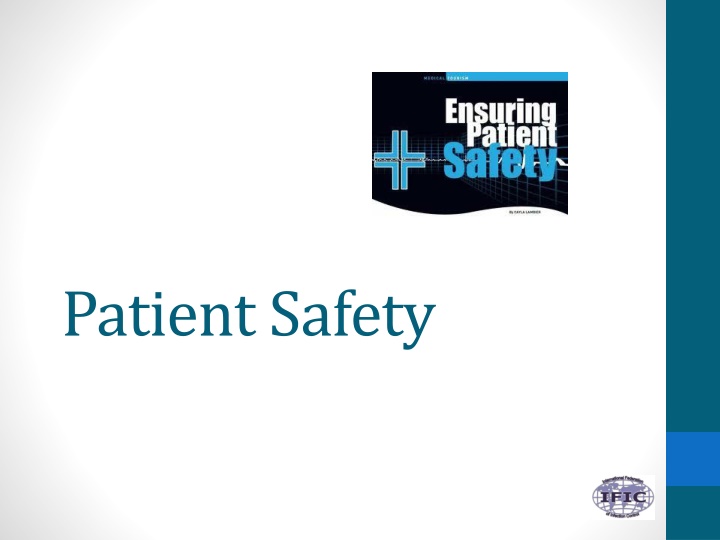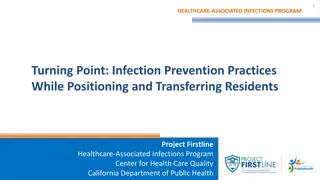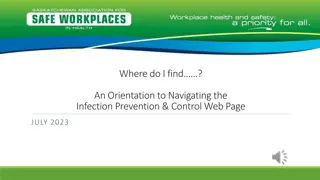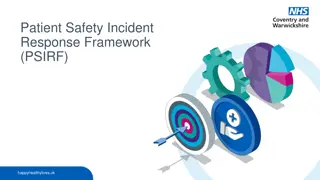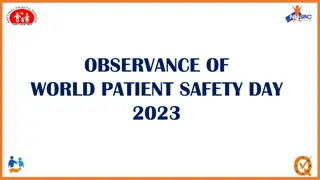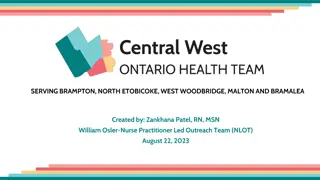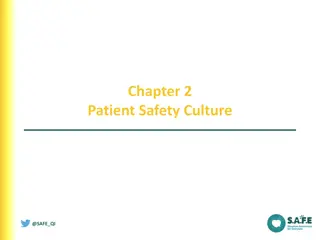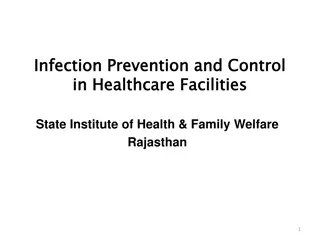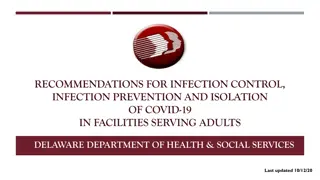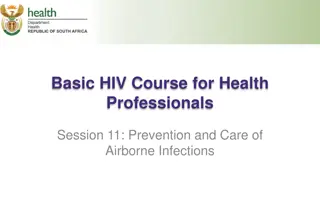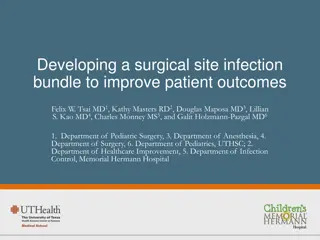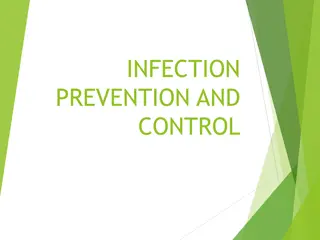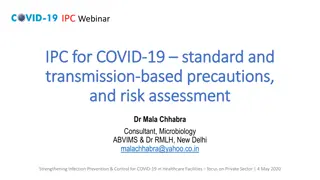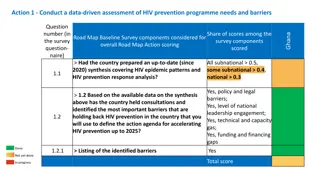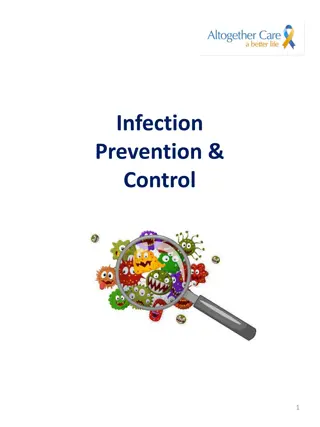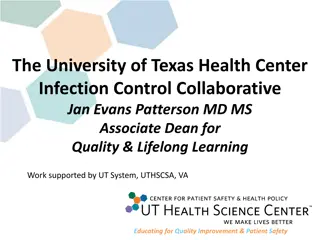Role of Infection Prevention and Patient Safety Culture
Early pioneers in infection prevention and patient safety programs promoted safe patient care. Understanding the role of infection prevention and control (IPC) and the elements of patient safety culture are crucial for healthcare professionals. Learn practical strategies for each element to enhance patient safety outcomes and reduce healthcare-associated infections. Explore the complexities of human behavior influencing patient safety in healthcare settings. Dive into the importance of establishing a culture of patient safety, including leadership, teamwork, evidence-based practices, effective communication, learning, measurement, and more.
Download Presentation

Please find below an Image/Link to download the presentation.
The content on the website is provided AS IS for your information and personal use only. It may not be sold, licensed, or shared on other websites without obtaining consent from the author.If you encounter any issues during the download, it is possible that the publisher has removed the file from their server.
You are allowed to download the files provided on this website for personal or commercial use, subject to the condition that they are used lawfully. All files are the property of their respective owners.
The content on the website is provided AS IS for your information and personal use only. It may not be sold, licensed, or shared on other websites without obtaining consent from the author.
E N D
Presentation Transcript
Learning objectives December 1, 2013 1. Describe the role of infection prevention and control (IPC) in patient safety programmes. 2. List at least eight main elements of patient safety culture. 3. For each element of patient safety culture, give at least one practical strategy for the IPC professional. 2
Time involved December 1, 2013 45 minutes 3
Introduction December 1, 2013 Early pioneers in infection prevention and control (IPC) promoted safe patient care through their work The World Health Organization Assembly voted in 2004 to create a World Alliance for Patient Safety to coordinate, spread, and accelerate improvements in patient safety worldwide 4
Why is there a patient safety problem in health care? Complexity of human illness and frailties of human behaviour may result in errors or adverse events Healthcare associated infections (HAI) may occur from: Commission (doing something wrong that leads to infection), e.g., not providing timely preoperative antibiotics for appropriate patients, OR FROM Omission (failure to do something right,) e.g., using poor aseptic technique when inserting a catheter December 1, 2013 5
A Culture of Patient Safety - 1 December 1, 2013 Culture has been defined as the deeply rooted assumptions, values, and norms of an organisation that guide the interactions of the members through attitudes, customs, and behaviours 6
A Culture of Patient Safety Outcomes December 1, 2013 7
A Culture of Patient Safety - 2 Involves: Leadership Teamwork and collaboration Evidence-based practices Effective communication Learning Measurement A just culture Systems-thinking Human factors Improvement philosophy December 1, 2013 8
Leadership - 1 December 1, 2013 Senior leaders are responsible for establishing safety as an organisational priority Leaders set the tone by: naming safety as a priority supporting approved behaviours, and motivating staff to achieve the safest care 9
Leadership - 2 December 1, 2013 Strategies for IPC professionals 1. Engage leaders throughout the organisation in support of IPC; assist them in increasing the visibility and importance of infection prevention 2. Seek commitment from senior executives, boards of governance, clinical and support department leaders, and key staff to IPC principles and practices 3. Present a compelling case to leaders that emphasises the decreased morbidity, mortality, and cost when infections are avoided 4. Provide leaders with valid information to help them make decisions about infection prevention 10
Teamwork and Collaboration - 1 December 1, 2013 Combine the talents and skills of each member of a team Serves as a checks and balance method Strong collaboration and teamwork help minimise adverse events. 11
Teamwork and Collaboration - 2 December 1, 2013 Strategies for IPC professionals 1. Foster collaboration and teamwork by engaging staff as partners in developing IPC policies and procedures 2. Encourage a multidisciplinary approach to IPC 3. Participate with teams of caregivers to address infection prevention issues 4. Maintain open communication about infection prevention to include staff and leaders across the organisation 12
Effective Communication - 1 December 1, 2013 Open communication encourages the sharing of patient, technological, and environmental information Communication strategies include use of written, verbal, or electronic methods for staff education, for sharing IPC data from surveillance, new policies, procedures, and literature studies Communication should include a reporting system that allows staff to raise practice concerns or errors in care without fear of retribution 13
Effective Communication - 2 December 1, 2013 Strategies for IPC professionals 1. Make routine rounds and discuss patients with infections or those at risk of infection with the direct care providers and listen to staff concerns 2. Share surveillance data and new information 3. Develop a secure system for staff to report infection risks 14
Evidence-based Practices - 1 December 1, 2013 Use of evidence-based strategies is a basic element of patient safety This means translating science into practice and standardising practices to achieve the best outcomes Adoption of best practices often mean changing practice Changing practice often meets with resistance 15
Evidence-based Practices - 2 December 1, 2013 Strategies for IPC professionals 1. Learn about the incentives and barriers to adopting and implementing preferred practices in the organisation 2. Address incentives and barriers in the planning of new and existing policies and procedures for infection prevention 16
Organisational Learning - 1 December 1, 2013 Support members so they can learn together improve their ability to create desired results embrace new ways of thinking transform their environment for better care 17
Organisational Learning - 2 December 1, 2013 Strategies for IPC professionals 1. Share infection information with all staff 2. Encourage staff to participate in formulating policies and procedures to reduce infection risk 3. Use adult learning principles to educate staff 18
Measuring Care: Processes and Outcomes - 1 December 1, 2013 IPC staff must collect and report reliable data To monitor compliance with patient care practices To identify gaps in care To understand adverse events experienced by patients 19
Measuring Care: Processes and Outcomes - 2 Strategies for IPC Professionals 1. Emphasise the importance of analysing and reporting infections to staff and leaders 2. Educate staff about their role for reporting infections in order to identify gaps in care that can be corrected 3. Be clear about the purpose and use for data that are collected. This involves precise definitions of colonisation vs. infection, consistent data collection processes, accurate capture of data, and validation of infection rates 4. Stratify data whenever possible for more precise analysis, for example, surgical site infections and infections in the new- born population 5. Determine when to maintain or to eliminate surveillance so that measurement is focused and useful December 1, 2013 20
Systems Thinking - 1 December 1, 2013 Virtually all processes in health care organisations are systems which contain interconnected components, including people, processes, equipment, the environment, and information 21
Systems Thinking - 2 December 1, 2013 Strategies for IPC professionals 1. Consider the entire system, i.e., how the individual parts interact and how the system should work, when designing even simple IPC processes 2. Ensure that the system provides for supplies, that staff can successfully perform the assigned task(s), that the infrastructure supports the desired behaviours, and that coordinating departments support the infection prevention process 3. Work with others to design a system to achieve and sustain success 22
Human Factors Theory - 1 December 1, 2013 How to enhance performance by examining the interface between human behaviour and the elements of a work process (equipment and the work environment) The design of a care process, such as an operation or cleaning a wound, can benefit from using human factors engineering to reduce infection risk 23
Selected Human Factors Principles December 1, 2013 Simplify the process: minimise steps and make the process logical and easy to perform, such as having all supplies readily available. Standardise the process: standardise equipment and processes, e.g., standardising care of intravascular catheters to prevent bloodstream infections. Reduce dependence on memory: provide clear written direction, cues, visual aids, and reminders, for items such as preoperative preparation, hand hygiene, isolation precautions, or removal of indwelling devices. Use forcing functions: make it difficult to do it wrong by using equipment like safety needles and needle disposal devices. Work toward reliability: performing a task correctly and consistently, focusing on how to avoid failure, for example, using aseptic technique to insert a Foley catheter into the bladder. 24
Human Factors Theory - 2 Strategies for IPC professionals 1. Integrate human factors engineering principles, such as standardisation, into patient care practices to promote success in reducing infection risk to patients or staff 2. Anticipate potential process failures in IPC strategies and incorporate methods to prevent them 1. Such as visual cues for staff of expected behaviours (i.e., posters and checklists for surgical preparation) or supplies such as safety needles 3. Ensure that individuals performing the work are competent, there is clarity about the task being performed, that the tools and technologies involved work properly, and the environment supports the care process December 1, 2013 25
No Blame Just Culture - 1 December 1, 2013 When potentially harmful events such as HAIs occur, an organisation can either review the systems of care and learn from the errors, or blame personnel for making them In a just culture (a key component of a patient safe environment) errors are addressed by providing feedback and encouraging productive conversations, and insisting on unbiased, critical analysis to prevent future errors 26
No Blame Just Culture - 2 December 1, 2013 Strategies for IPC professionals 1. Help maintain a just , no blame culture by continually focusing on evidence-based practices, epidemiology, and systems rather than blaming individuals 2. Use critical thinking to identify and analyse the causes of errors leading to infections so they can be prevented in the future 27
Improvement Philosophy - 1 December 1, 2013 To minimise infections (or errors), leaders must not tolerate non-adherence to proven prevention measures When best practices are known, these should be expected of all staff 28
Improvement Philosophy - 2 Strategies for IPC professionals 1. Monitor evidence-based practices for infection prevention, e.g., isolation/precautions procedures, hand hygiene, sterile technique, and cleaning, disinfection and sterilisation 2. Work to improve broken or dysfunctional processes of care and defective systems Such as lack of soap and water or alcohol gel for hand hygiene, personal protective equipment for staff safety, or appropriate ventilation systems 3. Stay up-to-date on evidence-based guidelines and integrate them into the infection prevention program 4. Focus less on simply achieving benchmarks for infections and work continually toward zero infections 5. Do not accept the status quo as a long term goal; continually strive to reduce infection rates December 1, 2013 29
Examples - 1 December 1, 2013 Patient Safety Issue Infection Prevention and Control Example A patient who is admitted and prepared for surgery is transferred or handed off from the admission unit to the nursing staff, the operating theatre staff, post anaesthesia staff, and back to the nursing unit. Inadequate skin preparation, lack of timely administration of prophylactic antibiotics, or poor care of the surgical wound may occur. Patients in intensive care, haemodialysis, and other high intensity units often have multiple lines , fluids, ventilators, dialysers, and other equipment that must all be managed to avoid infection risks. Indwelling urinary or intravascular catheters and ventilators should be removed when no longer needed. Utilities such as water and air can present a risk if malfunctioning. Potential Solutions Multiple transfers or patient hand offs between staff and services Education about each phase of the surgical process Clear communication strategies Monitoring of competence Reminders, checklists, visual cues Documentation and analysis of preoperative and postoperative processes of care with feedback to staff Multiple types of equipment used for patient care Education and training of staff on use of equipment Competency assessment before performing work Human factors engineering Equipment maintenance Environmental assessments 30
Examples - 2 December 1, 2013 Patient Safety Issue Infection Prevention and Control Example Patients with immunosuppressive diseases, burns, trauma, and high-risk conditions related to age (neonates) are prone to infections. They must be carefully assessed and monitored to prevent infections. Potential Solutions High-risk illness Staff education: observation and reporting criteria Population-specific criteria Clear policies and procedures Careful documentation, monitoring, and feedback to staff about infections Time management support; evaluation of workload; staffing and assignments Work environment design, such as (for hand hygiene) availability and location of water, sink design and location, alcohol-based solutions to decrease hand hygiene time Time pressure High intensity environments commonly have large workloads and limited time to complete essential infection prevention tasks. For example, nurses often indicate that they are too busy to wash hands or perform hand hygiene when appropriate. 31
Examples - 3 December 1, 2013 Patient Safety Issue Infection Prevention and Control Example Patients are at increased risk of unsafe care and infection during some procedures and with some medications. For example, the lack of preoperative antibiotics at the correct time and with the correct dose or discontinuation at the recommended time can fail to reduce risk of surgical site infections. Potential Solutions High-risk procedures/medications Develop clear protocols and processes for administration of preoperative antibiotics Educate staff about the procedures Assign responsibilities Monitor compliance with processes and report outcomes Initiate performance improvement when appropriate Provide work environment with few distractions Initiate culture of quiet and lack of interruption Encourage one task at a time Include staff in making decisions about work flow and environment Provide cues to remind staff of steps in an activity Distractions and multitasking Distractions during delivery of care or attempting to perform many tasks simultaneously can lead to errors. Staff may omit hand hygiene because of distractions during busy times. Staff using aseptic or sterile techniques may contaminate the area because of distractions. 32
Examples - 4 December 1, 2013 Patient Safety Issue Infection Prevention and Control Example Inexperience or lack of competence in healthcare personnel may lead to bad practice. For example, personnel who insert intravascular catheters and do not feel competent to use the recommended sites, such as the subclavian vein, may choose the femoral vein for insertion with its associated higher infection risk. Potential Solutions Inexperienced or incompetent care givers: Analyse why staff feel inexperienced Provide orientation / training for all staff who insert intravascular catheters, including rationale and supervised practice until competency is established Periodically monitor skills and provide feedback 33
Key Points December 1, 2013 Safe patient care, including infection prevention, is a priority in all health care settings A patient safety culture guides the attitudes, norms and behaviours of individuals and organisations In a safe culture of care, all staff and leaders assume responsibility for the well-being of patients Patient safety requires teamwork and collaboration, communication, measurement, and techniques such as human factors engineering, systems thinking, no blame - just culture and improvement philosophy 34
References 1. Thompson MA. Patient Safety. In: APIC Text of Infection Control and Epidemiology. 3rd edition. Association of Professionals in Infection Control and Epidemiology, Washington DC.2009; Chapter 12; 12-7-8. Grol R, Berwick DM, Wensing M. On the trail of quality and safety in healthcare. BMJ 2008; 336(7635):74-6. Murphy D. Understanding the Business Case for Infection Prevention and Control. http://www.vhqc.org/files/091020BusinessCaseForIPC.pdf A human factor engineering paradigm for patient safety: designing to support the performance of healthcare professionals. Qual Sat Health Care 2006; 15 (Suppl1):i59- i65.doi:10.1136/qshc.2005.015974 or http://ncbi.nlm.nih.gov/pmc/articles/PMC2464866 Donaldson LJ, Fletcher MG. The WHO World Alliance for patient safety: towards the years of living less dangerously. Med 2006; 184(10 Suppl):S69-72. December 1, 2013 2. 3. 4. 5. 35
Quiz December 1, 2013 1. Patient safety problems may be due to doing something wrong or failure to do what is correct. T/F? 2. A culture of patient safety includes a) Surveillance b) Standardisation c) Root cause analysis d) All of the above 3. Communication should always be verbal. T/F? 36
International Federation of Infection Control IFIC s mission is to facilitate international networking in order to improve the prevention and control of healthcare associated infections worldwide. It is an umbrella organisation of societies and associations of healthcare professionals in infection control and related fields across the globe . The goal of IFIC is to minimise the risk of infection within healthcare settings through development of a network of infection control organisations for communication, consensus building, education and sharing expertise. For more information go to http://theific.org/ December 1, 2013 37
